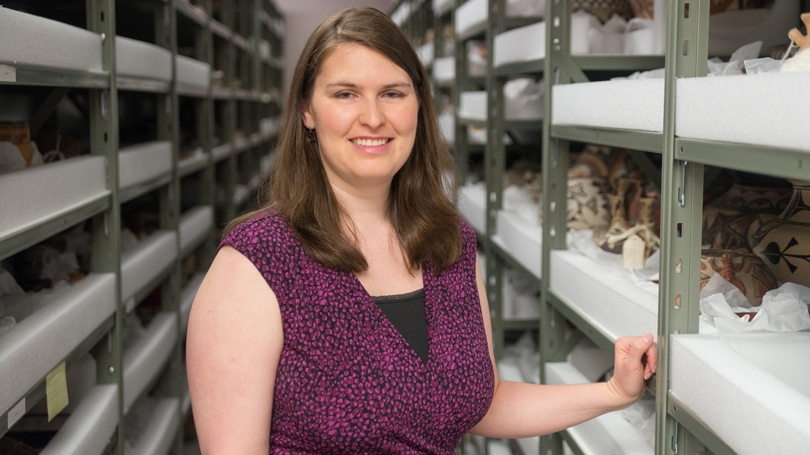
Menu
- Undergraduate
- Disciplines
- Artists in Residence
- Exhibitions
- Internships
- News & Events
- People
Back to Top Nav
Back to Top Nav
Back to Top Nav
Back to Top Nav
Back to Top Nav
Back to Top Nav
Back to Top Nav
For almost three decades, the Hood Museum of Art has been a destination for visitors to quietly appreciate and reflect on the art and artifacts it has collected—from ancient to new, lovely to unsettling, commonplace to rare.
Today, the museum boasts more than 70,000 objects. But it has never been just a larger-than-life-sized jewel box. Ever since Dartmouth consolidated its centuries-old collections under one roof in the mid-1980s, the museum has endeavored to fulfill a more active purpose—that of a teaching facility.
“Our mission is to create an ideal learning environment that fosters transformative encounters with works of art,” says Amelia Kahl, coordinator of academic programming at the Hood. The Hood is among the leaders of museums working toward this goal, drawing 140 academic programmers and museum educators from across the United States and three other countries to Dartmouth this past spring for a conference titled “Teaching Museums in the 21st Century: Moving Our Practice Forward.”
As a teaching museum, the Hood is dedicated to both creating learning opportunities for students and assisting the teaching and research efforts of faculty. “We think about how objects are a locus for questions and research,” says Kahl. “An object can lead you into many different areas of study and areas of human production and life. You can think about where something was made, how it was made. Its materials can tell you something about natural resources in the area and about production and technology techniques. What it depicts can talk to you about religion and belief systems. Who made it can talk to you about social stratification. Who paid for it can open up questions about politics, family structure, government, press and media, and how meanings are conveyed that way. So there are a lot of different questions that can come from a single object.”
Museum staff members often work with faculty on events and projects that showcase, as well as enhance, faculty research. The 75-plus teaching exhibitions at the Harrington Gallery have been the result of ongoing collaboration between Hood staff and faculty since 1990. Professors also contribute to exhibitions at the museum, such as this year’s “The Women of Shin Hanga” exhibition of Japanese prints, curated by Allen Hockley, associate professor of art history and an expert on Japanese print culture.
Many times, collaboration between faculty and staff takes the form of lectures and gallery talks, both on and off campus. When the Hood loaned its Picasso painting, Guitar on a Table, to the Steins Collect exhibition at the Museum of Modern Art, Professor of English Barbara Will accompanied the Hood’s curator of European art to New York to talk about the link between Picasso and Gertrude Stein; Will teaches a seminar on the writer.
All faculty can access the Hood’s collections and files, but Mellon Fellowships—one- to two-week paid residencies—provide recipients the opportunity for intense immersion in collections in their areas of expertise. Sienna Craig, associate professor of anthropology, used the fellowship to create a list of objects that augmented her lessons when she held class sessions at the museum.
“A lot of our faculty from constituent departments do their own teaching when they bring classes here, and that’s what we prefer because we feel that’s the way it’s best integrated,” says Kahl. “When we have faculty from outside who aren’t as comfortable teaching with objects, we often teach or co-teach with them, which can also be a useful model. But the more time they’ve spent with the objects, the better they can connect it to the larger themes of their course.”
Kahl recalls a professor who wrote an essay for a Hood catalog observing that the experience caused him for the first time to think about how art and geology intersected. “I think there are other faculty who find it hard to see the connection to their field if they don’t traditionally work with art or objects,” says Kahl, “but it’s there.”